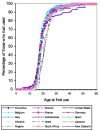Cannabis Epidemiology: A Selective Review
- PMID: 27526792
- PMCID: PMC5296933
- DOI: 10.2174/1381612822666160813214023
Cannabis Epidemiology: A Selective Review
Abstract
Background: Globally, the most widely used set of compounds among the internationally regulated drugs is cannabis.
Objective: To review evidence from epidemiological research on cannabis, organized in relation to this field's five main rubrics: quantity, location, causes, mechanisms, and prevention/ control.
Method: The review covers a selection of evidence from standardized population surveys, official statistics, and governmental reports, as well as published articles and books identified via MEDLINE, Web of Science, and Google Scholar as of July 2016.
Results: In relation to quantity, an estimated 3% to 5% of the world population is thought to have tried a cannabis product, with at least one fairly recent use, mainly extra-medical and outside boundaries of prescribed use. Among cannabis users in the United States, roughly one in 7-8 has engaged in medical marijuana use. In relation to location, prevalence proportions reveal important variations across countries and between subgroups within countries. Regarding causes and mechanisms of starting to use cannabis, there is no compelling integrative and replicable conceptual model or theoretical formulation. Most studies of mechanisms have focused upon a 'gateway sequence' and person-to-person diffusion, with some recent work on disability-adjusted life years. A brief review of cannabis use consequences, as well as prevention and control strategies is also provided.
Conclusion: At present, we know much about the frequency and occurrence of cannabis use, with too little replicable definitive evidence with respect to the other main rubrics. Given a changing regulatory environment for cannabis products, new institutions such as an independent International Cannabis Products Safety Commission may be required to produce evidence required to weigh benefits versus costs. It is not clear that governmentsponsored research will be sufficient to meet consumer demand for balanced points of view and truly definitive evidence.
Keywords: Cannabis; epidemiology; incidence; marijuana; medical marijuana; prevalence.
Copyright© Bentham Science Publishers; For any queries, please email at epub@benthamscience.org.
Figures


References
-
- Anthony J, Helzer J. Syndromes of drug abuse and dependence. In: Robins LN, Regier DA, editors. Psychiatric Disorders in America: The Epidemiologic Catchment Area Study. New York: Free Press; 1991. pp. 116–54.
-
- Holst P. On the Statistics of the Insane, Blind, Deaf and Dumb, and Lepers, of Norway. Journal of the Statistical Society of London. 1852;15:250–6.
-
- Gruenberg EM. A review of mental health in the metropolis: The Midtown Manhattan Study. Milbank Memorial Fund Quarterly. 1963;16:77–93. - PubMed
Publication types
MeSH terms
Substances
Grants and funding
LinkOut - more resources
Full Text Sources
Other Literature Sources
Medical

